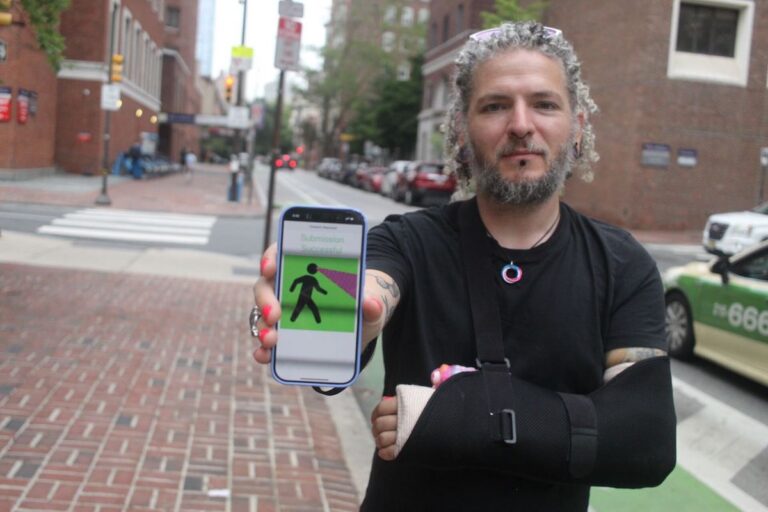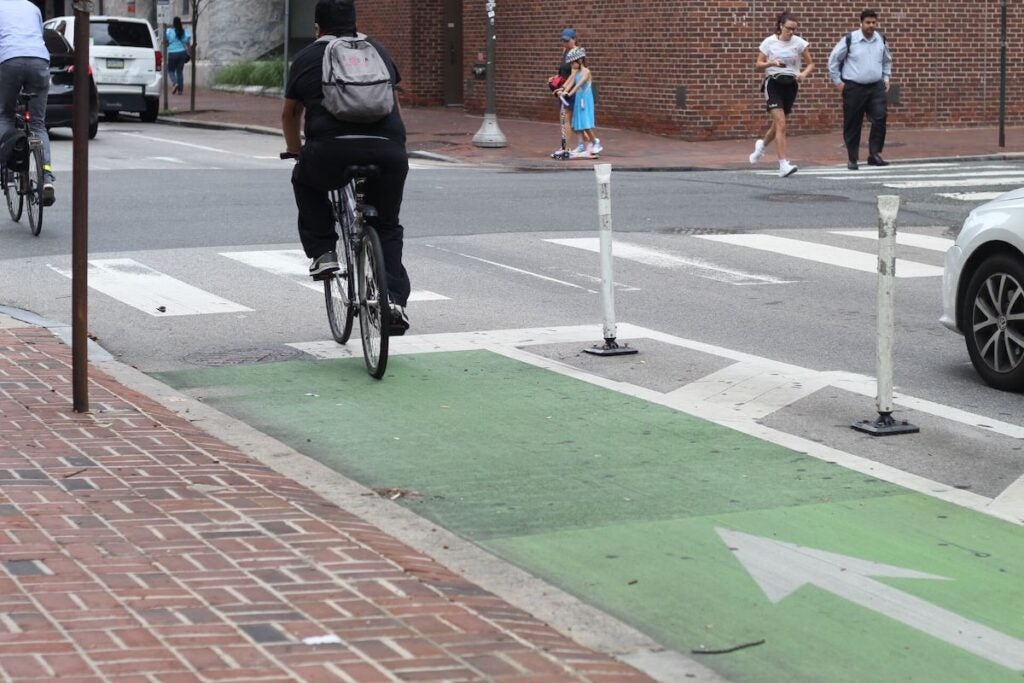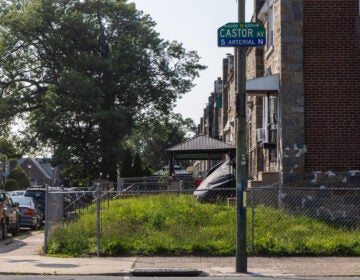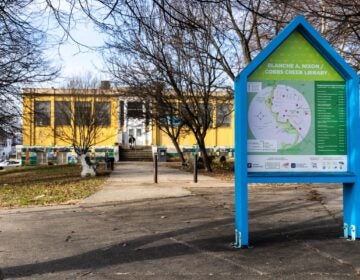A new app allows Philadelphians to report parking violations using ‘laser vision’
From illegal sidewalk parking to bike lane obstructions, violations captured by photo trigger an automatic report that gets sent to the PPA.

Ee Durbin, tech lead for Philly Bike Action, shows off Laser Vision, a digital tool to easily report mobility access violations. (Gabriel Donahue/WHYY)
Have a question about Philly’s neighborhoods or the systems that shape them? PlanPhilly reporters want to hear from you! Ask us a question or send us a story idea you think we should cover.
When Ee Durbin learned about the Philadelphia Parking Authority’s mobility access violation reporting form, they wondered how they could make it even easier for Philadelphians to report an issue that plagues the city’s streets — what Durbin referred to as “the way that people choose to put their vehicles at a standstill.”
Durbin is the technical lead for the volunteer group Philly Bike Action, and on June 26, the group released Laser Vision, a digital tool that streamlines the mobility obstruction reporting process.
Instead of manually typing in the make and model of the violating vehicle, the location of the offense and other requested information to complete the PPA form, users simply snap a picture of the violation on Laser Vision — a car blocking a bike lane or parked on a sidewalk, for example — and the software reads the details of the image to autofill the form, offers a chance for corrections if necessary and submits it.
Durbin said one user told them they’ve gotten it down to a 15-second process.

The concept is similar to Bike Lane Uprising, an app that creates a national database of bike lane violations. But Durbin considers Laser Vision more effective because it doesn’t just collect data “that theoretically could be used for advocacy in the future,” but immediately sends it to the agency that has the power to correct the issues.
When a violation is reported between 6 a.m. and 10 p.m., PPA’s patrolling hours, parking enforcement officers should report to the location to ticket the offender, according to Martin O’Rourke, a spokesperson for the authority. The form’s webpage notes that reports “may not result in immediate enforcement action.”
Additionally, O’Rourke said that if violations are frequently reported on “certain blocks or areas, we will inform our ticketing staff to make these areas a priority.”
Durbin told WHYY News that the group doesn’t just want increased enforcement of parking rules. Instead, the group advocates overall for protected bike lanes so that drivers aren’t physically able to access the same road space as cyclists.
On July Fourth, 27 violations had been reported through Laser Vision by about 4 p.m. The day before saw 95 reports. And in its roughly two weeks of usage — about a week of beta testing occurred before its launch — more than 1,200 mobility access violations have been submitted to PPA. That is nearly a third of the number of total reports PPA received in 2023 across all violations, according to O’Rourke. Though bike lane obstructions are the most common submission by Laser Vision users, that category was only recently added to the form.
A heatmap of the data is on Philly Bike Action’s website. It doesn’t give the exact location of reported violations and is updated roughly 30 minutes after each submission; both measures are to protect the privacy and safety of violators and reporters, Durbin said. There’s also a casual screening process by Philly Bike Action volunteers to ensure reports are legitimate.
Laser Vision is a result of one of the greatest thorns in the cycling community’s side, one that can be dangerous and even fatal.
“People will park their vehicles in places that they’re not legally allowed to, and [cyclists] have to make evasive maneuvers into traffic to get around it,” they said. “While fundamentally a lot of cyclists find that to be just a thing that they do, and a lot of people will even brush it off and be like, ‘Well, you just go around.’ The truth is that this infrastructure is for everyone, including the folks who are not confident on bicycles.”
The problem extends beyond just cyclists: pedestrians face similar issues when sidewalks are blocked, and this is especially true for disabled people who use mobility aids.

Amanda Parezo, an occupational therapist and professor at Jefferson University, has used a wheelchair for four years after a gunshot to her spinal cord paralyzed her from the waist down. She said she frequently goes into the street, dropping off curbs and sometimes falling, adding that she’ll regularly have to reroute to get past parked cars that block sidewalks and curb cuts as well as other obstacles like construction.
“I don’t leave the house a lot because I’m anticipating these problems happening,” she said. “It leaves people isolated because they don’t even want to go outside.”
Parezo advocates for improved mobility access across Philadelphia and praises the concept of Laser Vision, especially as an avid reporter of mobility access violations.
“I’m doing it in the moment as I’m rolling around the city. I’m having to sit there and do it all, so it’s nice to be able to have something that’s easier to use,” she said. “When I see people in the street, nearly getting hit or having to backtrack to get around a place, I can imagine a lot of families and caregivers finding it helpful.”
That’s exactly the kind of impact Durbin said Philly Bike Action is hoping for — while its primary user base is cyclists, they are encouraging all categories of violations to be reported.
“It’s not just about bike lanes,” Durbin said. “It really is about the totality of the problem of the way that people park.”

Subscribe to PlanPhilly
WHYY is your source for fact-based, in-depth journalism and information. As a nonprofit organization, we rely on financial support from readers like you. Please give today.







